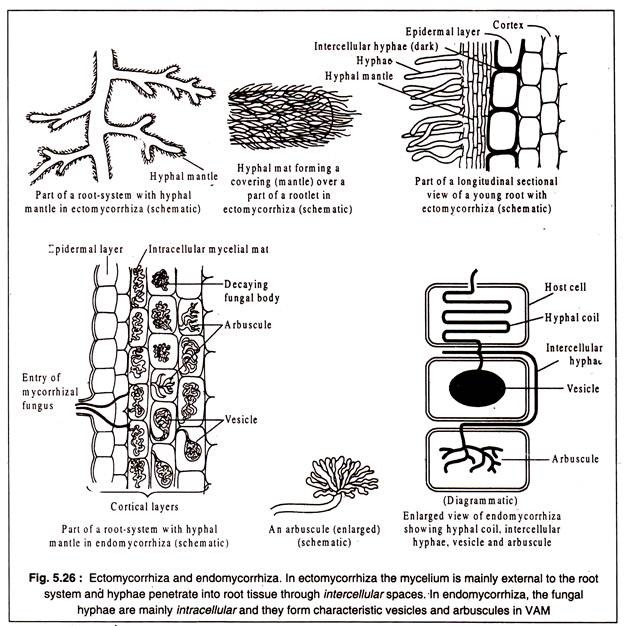In this article we will discuss about ectomycorrhizal versus endomycorrhizal fungi.
Ectomycorrhizal Fungi:
In ectomycorrhizal association, the fungus forms a mantle or sheath over the surface of fine lateral roots of the host trees and sends some hyphae into the intercellular spaces of the outer cortex forming a so-called Hartignet. Arbuscules and vesicles, characteristically present in endomycorrhizae are absent. The lateral roots covered by the fungal mantle often assume a swollen or coralloid form.
Ectomycorrhizal fungi is of great importance in afforestation. In developing pine forests, it is always ensured that the seedlings are inoculated with soil containing the appropriate strains of ectomyct rrhizal fungi. Trees with ectomycorrhizal association are capable of growing better under nutrient-deficient conditions in comparison to non-mycorrhizal plants, because of their greater ability to absorb nutrients from soil.
Many forest trees including both conifers, like Pinus, Cedrus, Abies, as well as deciduous non- conifers, like oak, beech, birch etc. form ecto-mycorrhizal associations. The fungal components also belong to different groups of mostly higher fungi. Basidiomycetes, like agarics and gasteromycetes are common. The truffles belonging to ascomycetes are able to associate with pines. Some of the common genera of ecto-mycorrhizal fungi are members of Russula, Clitocybe, Boletus, Lactarius, Tuber etc.
Endomycorrhizal Fungi:
Endomycorrhizal associations are more common than the ecto-mycorrhizal ones and they are found in almost all groups of higher plants. The best known endo-mycorrhizae are those of orchids. It is well- known that under natural conditions, orchids are unable to grow without association with fungi.
The endomycorrhizal fungi enter into the root cells and are generally restricted to the cortical region rarely crossing the endodermis. The vesicular-arbuscular types form characteristic structures within the cells. After growing for some time in the cells, these structures degenerate and eventually decompose, thereby providing nutrition to the host. Thus, in VAM the plant host is directly benefited.
The endomycorrhizal fungi are entirely restricted to the roots and they never infect the green parts of the plants. Possibly, some inhibitory principle elaborated by the green parts prevents the fungi to encroach the aerial portions. This is suggested by absence of fungal growth in the root just below the aerial parts.
The identity of the fungal components of endo-mycorrhizae is often obscure. Both phycomycetes as evidenced, by aseptate nature of the hyphae and higher fungi including basidiomycetes and fungi imperfecti have been implicated as components. Many species of orchids and Ericaceae have phycomycetous type fungi, though the orchid, Gastrodiaelata is known to associate with the basidiomycetes, Armillaria mellea.
This orchid does not flower unless it enters into association with the fungus. Some other orchids are known to form endomycorrhiza with species of Rhizoctonia, like R. repens. Among VAM fungi, species of Pythium have been found in many species of Liliaceae. The genus Endogone has been claimed as fungal component of VAM in apple, strawberry and some other plants. VAM has been found in many species of monocots and dicots belonging to Gramineae Leguminosae, Compositae, Palmae etc.
Schematic representations of ectotrophic and endotrophic mycorrhizae are shown in Fig. 5.26:
